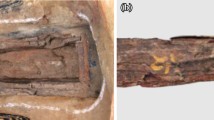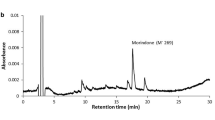Abstract
The potential of thermogravimetric analysis (TG) as a tool for the characterisation of ochre paint used in indigenous Australian bark paintings has been investigated. TG has been combined with differential scanning calorimetry (DSC) and mass spectrometry (MS) to identify and quantify the main inorganic and organic components present in the paints. The results obtained were supported by comparison with infrared spectra and XRD data obtained for the same specimens. The potential of thermal methods for the characterisation ochres has been demonstrated, with subtle differences between small samples being able to be identified.











Similar content being viewed by others
References
Perkins H, West M, editors. One sun one moon: aboriginal art in Australia. Sydney: Art Gallery of New South Wales; 2007.
Creagh DC, Kubik ME, Sterns M. One the feasibility of establishing the provenance of Australian Aboriginal artefacts using synchrotron radiation X-ray diffraction and proton induced X-ray emission. Nucl Instrum Methods Phys Res A. 2007;580:721–4.
O’Neill PM, Creagh DC, Sterns M. Studies of the composition of pigments used traditionally in Australian Aboriginal bark paintings. Radiat Phys Chem. 2004;71:841–2.
Creagh DC. The characterisation of artefacts of cultural heritage significance using physical techniques. Radiat Phys Chem. 2005;74:426–42.
Creagh D, Lee A, Otieno-Alego V, Kubik M. Recent and future developments in the use of radiation for the study of objects of cultural heritage significance. Radiat Phys Chem. 2009;78:367–74.
Creagh DC, Otieno-Alego V. The use of radiation for the study of material of cultural heritage significance. Nucl Instrum Methods Phys Res B. 2004;213:670–6.
Madejova J. FTIR techniques in clay mineral studies. Vib Spectrosc. 2003;31:1–10.
Genestar C, Pons C. Earth pigments in painting: characterisation and differentiation by means of FTIR spectroscopy and SEM-EDS microanalysis. Anal Bioanal Chem. 2005;382:269–74.
Ip KH, Stuart BH, Ray AS, Thomas PS. A spectroscopic investigation of the weathering of a heritage Sydney sandstone. Spectrochim Acta A. 2008;71:1032–5.
Cornell RM, Schwertmann U. The iron oxides: structures, properties, reactions, occurrences and uses. Weinheim: Wiley-VCH; 2003.
Bertraux J, Frohlich F, Ildefonse P. Multicomponent analysis of FTIR spectra: quantification of amorphous and crystallized mineral phases in synthetic and natural sediments. J Sediment Res. 1998;68:440–7.
Guo Y, Bustin RM. FTIR spectroscopy and reflectance of modern charcoals and fungal decayed woods: implications for studies of inertinite in coals. Int J Coal Geol. 1998;37:29–53.
Genestar Julia C, Pons Bonafe C. The use of natural earths in picture: study and differentiation by thermal analysis. Thermochim Acta. 2004;413:185–92.
Frost RL, Ding Z, Ruan HD. Thermal analysis of goethite: relevance to Australian indigenous art. J Therm Anal Calorim. 2003;71:783–97.
Dweck J. Qualitative and quantitative characterization of Brazilian natural and organophilic clays by thermal analysis. J Therm Anal Calorim. 2008;92:129–35.
Onishi A, Thomas PS, Stuart BH, Guerbois JP, Forbes S. TG-MS characterisation of pig bone in an inert atmosphere. J Therm Anal Calorim. 2007;88:405–9.
Author information
Authors and Affiliations
Corresponding author
Rights and permissions
About this article
Cite this article
Thomas, P.S., Stuart, B.H., McGowan, N. et al. A study of ochres from an Australian aboriginal bark painting using thermal methods. J Therm Anal Calorim 104, 507–513 (2011). https://doi.org/10.1007/s10973-011-1336-9
Published:
Issue Date:
DOI: https://doi.org/10.1007/s10973-011-1336-9




